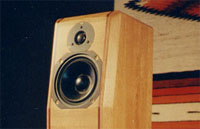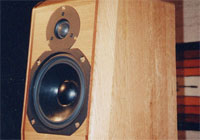This is a look at the speakers I presently use with the 6V6 amp on the other pages.
 Here's what they look like. Image is a thumb.
Here's what they look like. Image is a thumb.
 A little closer detail shot. Also a thumb.
A little closer detail shot. Also a thumb.
If there's a single major stumbling block in vacuum tube ultra-fi audio, it has to be the speakers. The best of the power amps, sonically speaking, tend to be pretty low powered, between one and ten watts, typically; and this problem is exacerbated by a high output impedence that both limits their output and causes frequency response anomalies into unkind loads. From a practical design standpoint, a speaker system with a high sensitivity, an even and extended frequency response, and a fairly high and even input impedence is a lot more difficult to cook up in the old garage than a good little amp.
These speakers were designed and built back when I had sixteen watts to burn (P-P EL34's), and have been refined somewhat for better sonics and for the lower power of the 6V6 amp. The basic design was that of a classic Butterworth vented-box two way. The bass-mid is the (since superceded) Audax HM170G0; chosen for its okay (90dB) sensitivity, low (42Hz) Fs, smooth response, and optimum (0.36) Qts for this type of box. The tweeter shown is the Morel MDT-30, but I found this tweet to sound a little ringy and slightly rolled-off. The tweeter in this system now is the Ralph Gonzalez fave Seas H225; a cheap polyamide-dome 19mm unit with remarkably good sound, which is also no longer made.
The Butterworth box for the Audax calculated to about 22 liters, and that's what this one is. It's 26½" tall (without the stands), 12" deep, and 9¼" wide, tuned to Fs with a 2" port, and made of 1½" thick white oak lumber. The stands are made of kerf-bent oak-veneered ¾" plywood, and are 13" tall. The speaker box weighs about 70 pounds, and the stands are filled with sand and weigh another 60 pounds or so. They're a bummer to move around. The box is lined with a damping material made from a viscoelastic architectural sealant loaded with sand, then half-inch felt carpet pad, and some polyester fluff behind the bassmid. They're 3dB down at 42Hz, and not horribly bloomy with a zero-NFB amp; which also has to do with the crossover.
Crossovers are an interesting thing. Educated opinions range from those of Joe D'Appolito and other high-end designers who feel that the crossover can be used to tailor the response pretty much at will, to those of Paul Voigt and the Euro guys, such as Sonus Faber and Reference 3A, who feel that the less crossover, the better. Ralph Gonzalez (also a very sharp guy) made a good case a few years ago in SB for two-pole (12dB/octave) crossovers, as they are tunable for both frequency and phase (their Q is adjustable). When I read his article, I ordered every size 14ga coil and SCR cap that Elliot Zalyet had, and went on a Mission. I tried everything; all combinations of 6, 12, and 18dB slopes I could think of, and came to an unavoidable sonic realization.
The Euros are right. No matter how perfect you get the amplitude and phase with complex crossovers, they end up with that high-end sound: flat, dry, boring. Even when they had noticeable colorations, the first-order networks had a livliness and transparency that made them musically engaging. I ended up with the classic 3KHz 6dB deal in this system.
Recently, however, I got interested in trying to minimize the crossover even farther. Now, the problem with first-order networks, really, is the demands that their shallow slope makes on the out-of-band response behavior of the drivers: and trying to simplify the network even more qualitatively exacerbates this problem. You can't really take the cap out of the tweeter line; you must protect the tweet from midband power, especially around tweeter Fs. This leaves the choke in the woofer line; which, at a glance, looks like it well might be removed. The problem here is that the woofer has to have a well-behaved rolloff on top, with none of the nasty resonances that most modern-material cones have. I first tried this with my little minimonitor version of this speaker system, which uses a RS 40-1354 and the Seas tweeter in a 9L box. The wildness of the 40-1354 around 8-12KHz gave the system a white sort of tonality that I couldn't live with, but wow; the tightness of the bass, and the coherency of the midrange and lower treble! I was back on the Mission. Looking at the plot and waterfall of the Audax in the big box, I saw that it was, in fact, ideal for this treatment. I pulled the coil from its line, changed the tweet to the Seas unit, and reduced the tweeter cap from 6.8µF to 4µf to match the natural rolloff of the HM170G0. Fabulous. This is the current setup, and sometimes it's so lifelike that it scares me. The Audax does have about a 2dB rise in its response from 500Hz to 2500Hz or so, which makes the system a little bright (tenor sax sounds too hot; not smoky enough), and system sensitivity is just 90dB, so my research into esoteric flea-power amps is on hold while I look for more sensitive alternatives; but its transparency and zero-NFB load friendliness keep it in in the main system . . . for now.